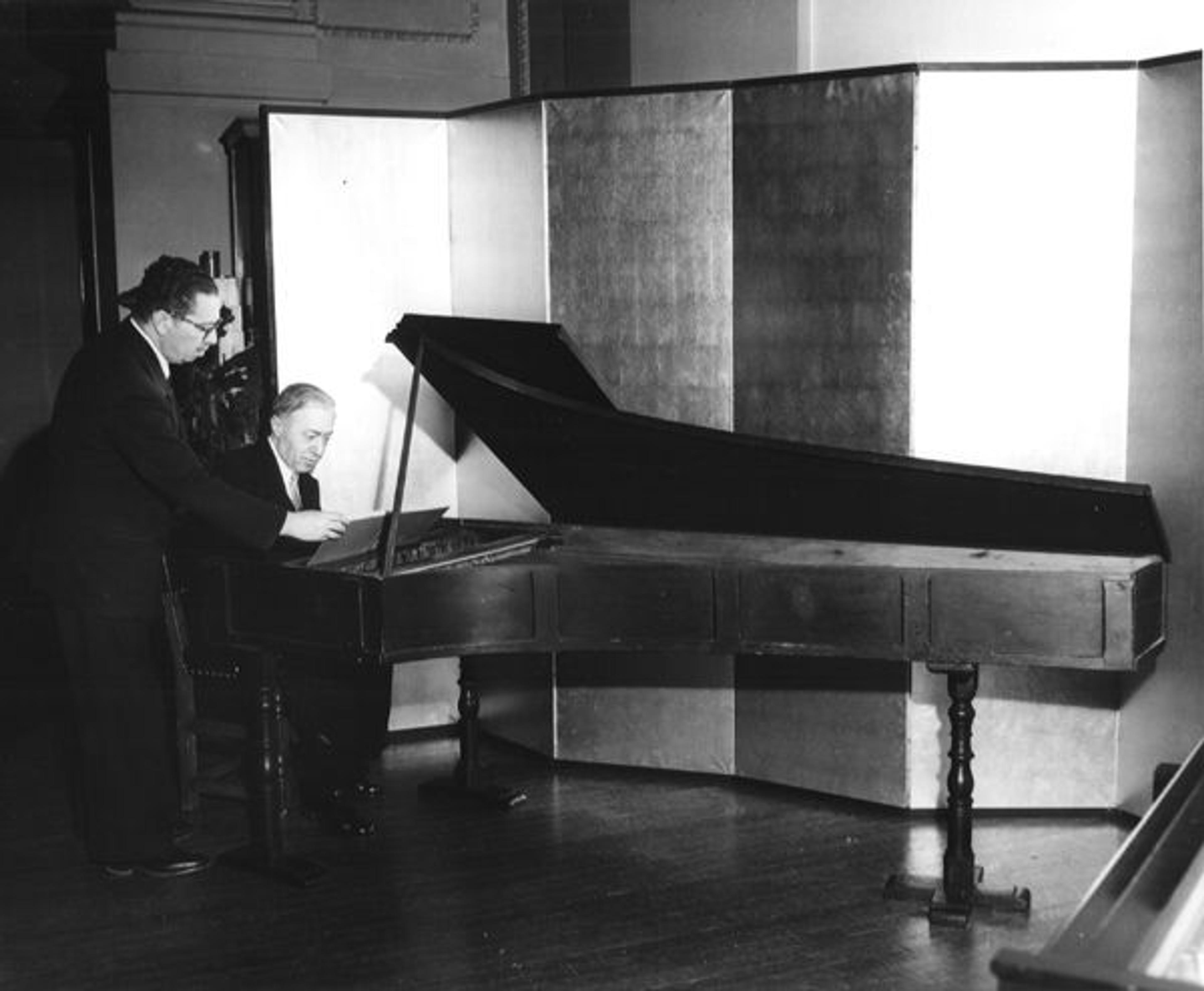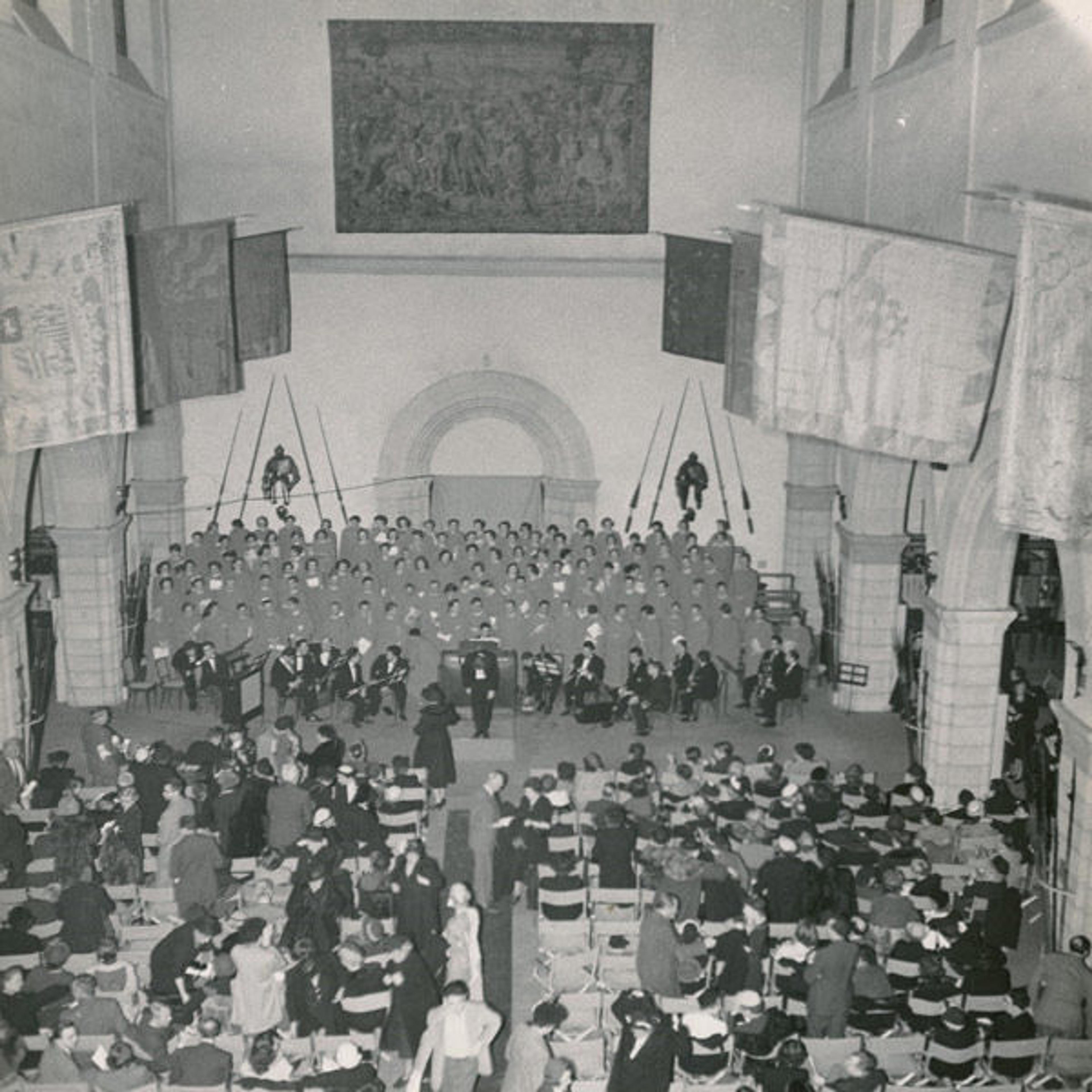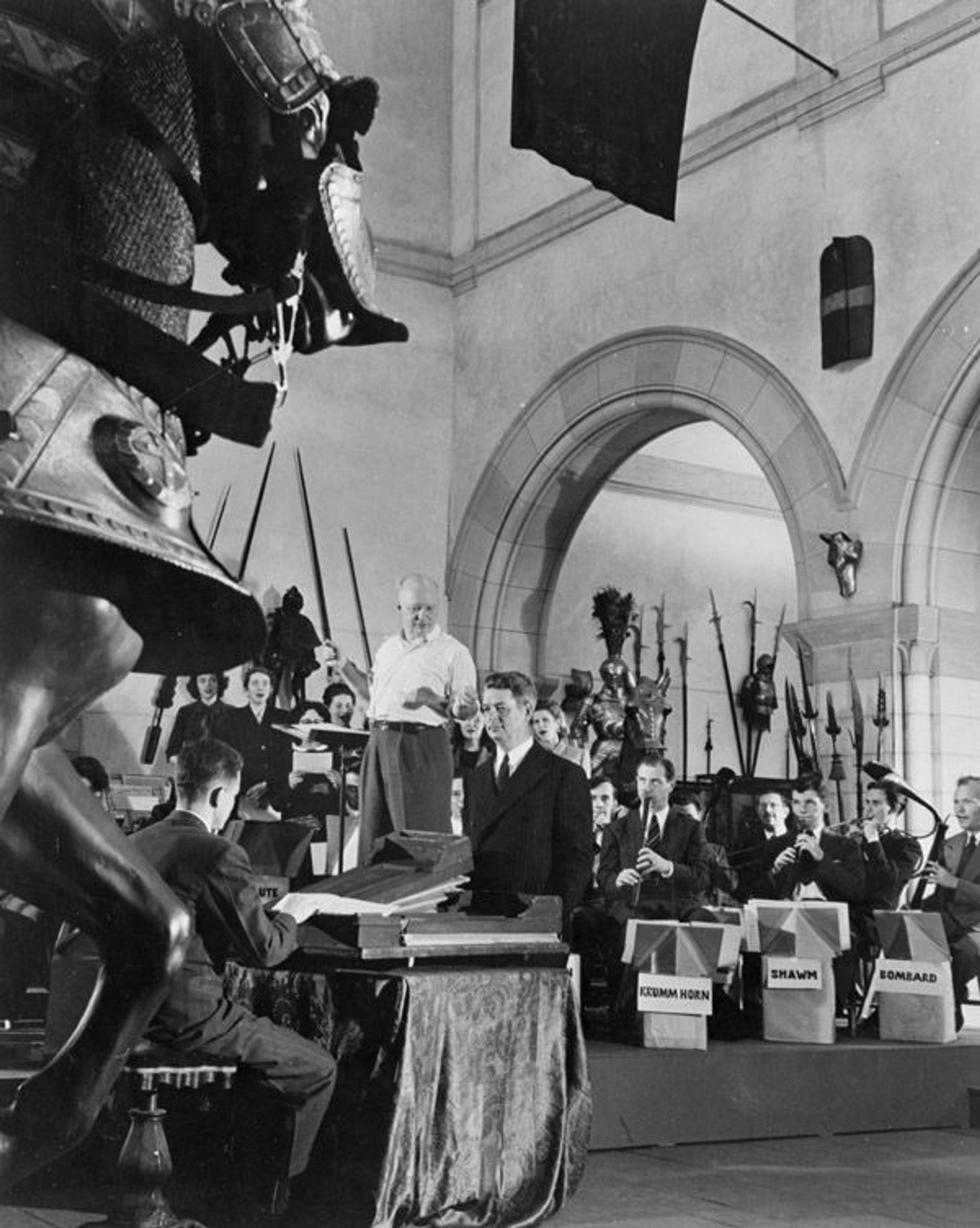Emanuel Winternitz and the Museum's Member Concerts

Pianist Mieczyslaw Horszowski first played at the Met for a Member concert in 1944, and continued to perform frequently at the Museum for more than thirty years. Here, at a concert in the 1940s, Winternitz turns pages as Horszowski performs on the Museum's 1720 grand piano by Bartolomeo Cristofori.
«Beginning in the early 1940s, the Met became home to a remarkable series of free concerts performed on many of the finest instruments in the Museum's collection. The concerts came about thanks to the efforts of the first curator of the Department of Musical Instruments, Emanuel Winternitz, who believed that the instrument collection needed to be heard as well as seen in order to be fully appreciated. While the use of musical instruments has always been an important part of understanding and interpreting them as art objects at the Metropolitan Museum, the philosophy of the time was much more liberal than today's conservation-minded approach. The concerts began in early 1943 and continued for more than a decade until the creation of a Department of Auditorium Events (later Concerts and Lectures), which gradually replaced the Winternitz-era scholarly programming with more mainstream attractions for which it could charge admission.»
In many cases the featured performers on these Member concerts were personal friends of Winternitz, often from his years in Europe before World War II, who, like Winternitz, had fled Europe to find safe haven in the United States. That Winternitz was able to attract them to give concerts in the Museum's small galleries rather than the world's great concert halls testified both to the respect he garnered from the performing arts community, and to the world in which he lived.
International travel was virtually at a standstill in 1943, and great artists were supporting themselves as best they could. Even the small honoraria paid by the Museum to performers was a help; moreover, for many of these artists, giving performances in the country that had provided them a home was their noble contribution to the war effort. After the war, the reputation of the Museum's Member concerts was such that almost no one turned Winternitz down, and eminent musicians such as Igor Stravinsky made strenuous efforts to put the performances at the Met on their schedules.

The Dessoff Choir performed on several Member concerts beginning in 1944—including here in the Arms and Armor Court, on April 27, 1950, when their program included works by Perotinus and Guillaume de Machaut.
Winternitz inaugurated the Member concert series by asking Adolph Busch and his chamber players to give six concerts, beginning on February 6, 1943. Winternitz gave lectures to accompany each concert, and he became known as the chairperson of the "Department of Musical Activities," or the "Department of Music," as shown on concert programs of the time.
The first season of Member concerts initially took place on a temporary stage in what is now the Arms and Armor Court. The following year, the series had 5,646 attendees, and beginning in 1945, the concerts were given twice each so as to accommodate more attendees. By 1946 the series attracted 7,552 listeners and had to be transferred to the larger-capacity Great Hall. Later concerts were then moved to smaller galleries and the Museum's formal Lecture Hall.
For the Member concerts, Winternitz deliberately selected seldom-heard works, including compositions by Giovanni Gabrieli, Heinrich Schütz, and Hugo Wolf. For as long as Winternitz was responsible for programming Museum concerts, he continued to champion the performance of non-mainstream works.
If the works performed at these concerts were not well known, the performers certainly were. Winternitz invited a range of the world's greatest musicians, including harpsichordist Ralph Kirkpatrick, pianist Mieczyslaw Horszowski, as well as George Szell, Wanda Landowska, and Paul Hindemith conducting the Yale Collegium Musicum.

Hindemith and the Yale Collegium Musicum rehearse in the Arms and Armor Court before their concert in May 1948. The seldom-heard early instruments are labeled "shawm," "krummhorn," etc. for the benefit of the audience. The State Department recorded this concert for the Voice of America series, which continued to record and disseminate Winternitz's Member concerts until at least 1955.
For each concert Winternitz lectured and demonstrated many of the instruments from the Museum's collection and wrote comprehensive scholarly program notes, which included discussions of relevant instruments which he brought to be displayed at the performances. In this way, he reassured New York's commercial concert halls and their union musicians that the Met's concerts were educational outreach, and not competition.
The quality of the concerts attracted wide praise from noted figures, including the conductors Bruno Walter and Arturo Toscanini, and favorable press coverage. Life magazine sent the photographer Eileen Darby to cover a rehearsal in the Arms and Armor Court for a 1948 Member concert, and soon there were requests to broadcast and record the performances. Columbia Records sold a twenty-six-disc set of the 1946 Member concerts of Adolph Busch conducting the Handel concerti grossi, and local radio station WNYC broadcast a number of the concerts live, while recording others. Musical America, a respected national periodical, reviewed the May 18, 1953, Member concert as:
. . . one of the most unusual and loveliest concerts heard in New York this season . . . since neither the academic nor the virtuoso approach to medieval and renaissance music leads to performances that do it justice, most of it still remains unloved, if not unknown, by concert audiences. . . . only through Mr. Hindemith . . . [can] the remote and seemingly obscure beauties of music from ages past be revealed to men of the hectic and complex twentieth century.
After the Grace Rainey Rogers Auditorium opened in 1954, the Museum's Department of Auditorium Events was formed and began exercising some administrative oversight over concerts held in the new venue. Winternitz continued to have artistic responsibility for at least two concert series every year for the next two decades, but these were public concerts for which admission was charged, although in some cases there was a reduced rate for Members. The opening of the auditorium effectively ended the free Member concerts as Winternitz had organized them for twelve memorable years, although his innovative programming and distinguished program notes continued to grace Museum concerts for decades to come.

Paul Hindemith conducts the Yale University Collegium Musicum in a Member concert at The Cloisters museum and gardens, June 4, 1951
Audio recording of several Member concerts, as well as Winternitz's accompanying lecture given on April 23, 1953, can be found in A Harmonious Ensemble: Musical Instruments at the Metropolitan Museum, 1884–2014, a comprehensive history of the Department of Musical Instruments.
Rebecca Lindsey
Rebecca Lindsey is a member of the Visiting Committee of the Departments of Musical Instruments and Islamic Art.